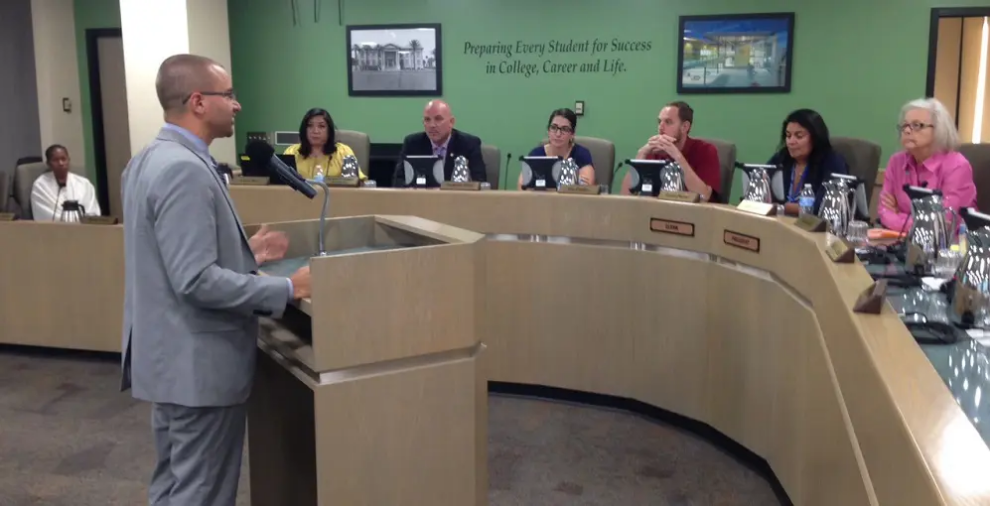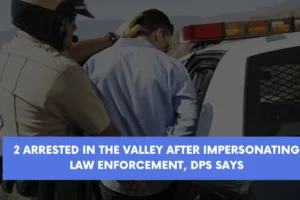School district governing board elections are on many ballots this year, and here’s what you need to know about them.
School boards set the direction for the district, from choosing the superintendent, to adopting the textbooks students will use, to setting the school calendar and daily schedule, to deciding whether schools will be open or closed to protect student safety, said Chris Kotterman, director of governmental relations for Arizona School Boards Association.
 Chris Kotterman
Chris Kotterman
“School boards also adopt the budget that allocates all the funding a district receives, and decide when to go to the voters to ask for funds to build or repair buildings (bonds) or to support district programs (overrides),” Kotterman said.
“Your local school board is the place where local, state and federal rules and laws are translated into actions that directly impact students and staff,” Kotterman said.
School board members also provide oversight for the school district, evaluate the superintendent, and approve the policies that provide structure for employees and students, said Julie Bacon, Paradise Valley Unified School District Governing Board Member.
“What boards do not do is run the day-to-day operations of the school district. They hire the superintendent to do that job,” Bacon said.
School board members are not paid and they spend a large amount of time working with and listening to the concerns of school leaders, teachers, staff, students, families and the communities they serve.
They also must be able to work with their fellow board members as a team to get things accomplished, said Bacon, who also is a board support and training specialist with Arizona School Boards Association.
 Julie Bacon
Julie Bacon
“Building positive working relationships with other board members when becoming a new member of a board is critically important,” Bacon said.
While serving on a school board is difficult at times, it is also rewarding, Bacon said.
“To be able to support the success of every student, influence the direction the district is going, create positive and safe learning and teaching environments and address the needs to the community makes the job of a school board member incredibly impactful,” Bacon said.
“I think there has been a realization during the (COVID-19) pandemic that schools truly are the cornerstone of communities and there was a significant void when schools closed,” Bacon said.
School boards key role during COVID-19
It became clear early in the COVID-19 pandemic, “just how much our communities depend on our public schools,” said Nikkie Whaley, governing board member for Washington Elementary School District.
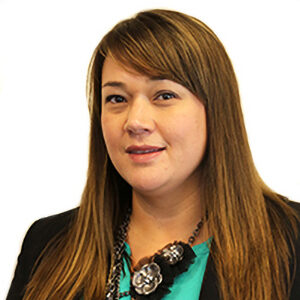 Nikkie Whaley
Nikkie Whaley
“People were looking to their schools for food. They were looking for technology. They were looking for a safe place for their kids to be. They were looking for social emotional support and our schools are really there for those people,” said Whaley, who also serves as a board support and training specialist with Arizona School Boards Association.
Not only for Washington Elementary public school students, but for charter school students in the area too, Whaley said.
School district governing boards began working to keep students and staff safe by initiating in-person school closures in March before the state took action, said Steven Chapman, board member with Tolleson Union High School District.
“We are also the ones who will continue to be emailed, and tagged in social media posts about when we reopen, when we will allow extra-curriculars, and what we are doing to ensure safety,” said Chapman, who also serves as president of the Arizona School Boards Association Board of Directors. “This is one of the few times when a Board Member will hear from parents, constituents and staff more frequently.”
Students’ internet access at home, how well some students adapted to online learning, and knowing when this will end are among some of the challenges school boards faced, Whaley said.
In these and other situations, school board members need to make sure that school administrators are bringing as much information to the table, and discussing the pros and cons of all recommendations for their specific communities, Chapman said.
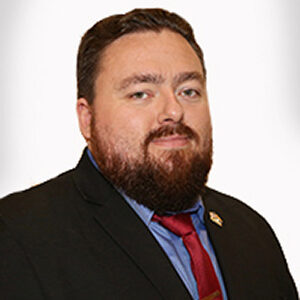 Steven Chapman
Steven Chapman
“A lot of people were scrambling for how to teach online, and many were looking at kind of out of the box online curriculum, but ultimately what we decided is to have our teachers work in teams and develop grade-level content which was given to teachers throughout the district along with support on how to use Google Classroom, Dojo and other online tools,” Whaley said. “We’ve heard it was much more engaging and individualized than some of the other things people are receiving.”
“Sitting school board members have had the weight of the world dropped on their shoulders by other elected officials unable or unwilling to take decisive action,” Kotterman said. “They have been faced with incredibly difficult and emotional decisions about whether and how to open schools amid a pandemic.”
“On top of all that, those running for re-election have had to invent new ways to campaign during the same pandemic,” Kotterman said. “Candidates were challenged from the very beginning as essentially the only elected officials in Arizona who were forced to go gather signatures to qualify for the ballot in person, while other candidates could use the state’s online system.”
“Their reward for winning a term on the school board in 2020 will be more tough decisions as we continue to work through issues associated with contagious disease and how to reimagine school into a more flexible institution than it has historically been,” Kotterman said.
Arizonans realized during this pandemic the huge role school boards play in how their schools are run, Kotterman said.
“It’s likely that throughout this pandemic and perhaps beyond, school board members are going to be facing a lot more controversy and public pressure than they’re used to,” Kotterman said. “Many board members may be tempted to give up, but this is precisely the time we need experienced members with institutional knowledge in addition to new and innovative ideas.”
Elections info and challenges this year
This year, 73 school governing board seats will be filled without an election, because only one candidate is running for the seat, so the county superintendent of schools will appoint those candidates, reports The Arizona Republic.
Along with difficulty of collecting signatures due to the Stay Home, Stay Safe order, other concerns may have weighed on people considering serving on school boards, Chapman said in an interview with KJZZ 91.5 FM.
“For some people, this is a challenging time and they may not feel that they can step into those shoes right now,” Chapman said.
Yet, 37 people statewide choose to register as a write-in candidate for school board. You’ll have to write-in by hand the name of the candidate you choose, because their names won’t be on the ballot because they didn’t collect signatures.
Related articles:
Questions about Prop. 208, school bond, override elections? Find answers here
School boards face tough decisions on when to re-open schools for in-person classes
Want to serve students? Here’s how to be a write-in school board candidate
Interested in running for school board? Sign up for webinars
“The important thing to remember here is that Governing Board Members are elected officials. These positions are just as important as voting on candidates for President of the United States, City Council members, and other state elected offices,” Chapman said to AZEdNews.
“Just like any other candidate, it is important to know who is asking for your vote,” Chapman said. “These elected officials control budgets ranging from millions to hundreds of millions of dollars, they hire the superintendent who runs the day to day operations of the district, as well as setting the direction and the culture for that district.”
It might be difficult to find information on school board candidates because they’re not part of the Voter’s Guide, but candidates do submit statements to their county superintendent of school’s webpage and voters can check there, Whaley said.
Also, voters can check for website or Facebook candidates’ pages, which many candidates have, Whaley said. Another option is to find other parents or community members you respect in the district and see if they can give you some perspective as well, Whaley said.
School boards are one of the last nonpartisan elected positions in local government, and “school districts are best run by citizens who are most closely connected with the communities they serve, Bacon said.
As experienced school board members leave their positions, there are opportunities for people considering serving the students, families and schools in their neighborhood to run for school governing board positions.
Now more than ever, it is important for Governing Board Members and educators to highlight that public-school districts are a beacon of optimism, Chapman said.
“Public school districts do not turn away kids, and always find a way to provide community-based solutions. School districts are the example of government that works,” Chapman said.
“The most important thing to remember is that as long as you’re putting kids first, you’re putting student achievement first and their well-being first then you make the best decisions that you possibly can,” Whaley said.
“Serving the community in which you live is both an honor and a privilege, and it’s why citizens who care about the neighborhoods in which they live should consider running for a school board position,” Bacon said.
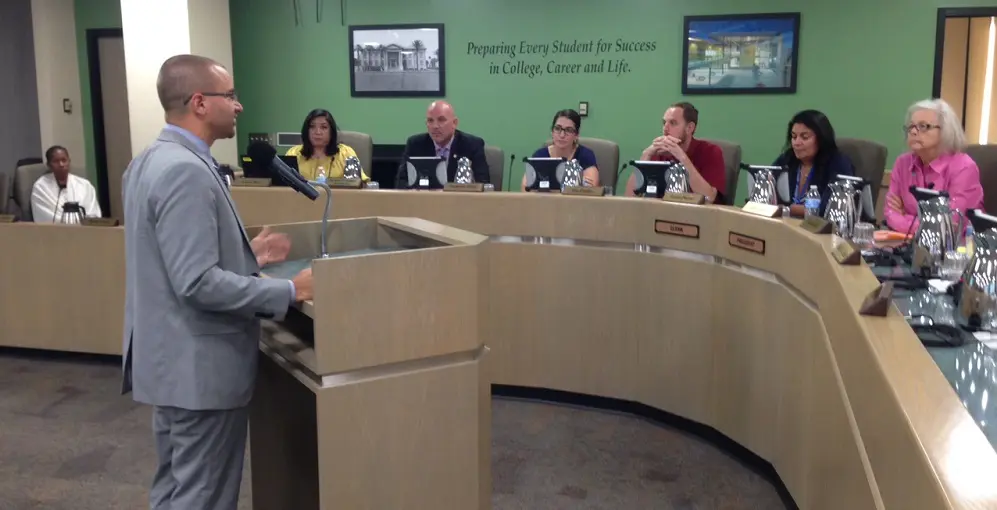
Phoenix Union High School District Supt. Dr. Chad Gestson speaks with members of the school district’s governing board. Photo courtesy of Phoenix Union High School District








